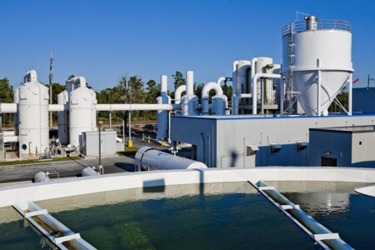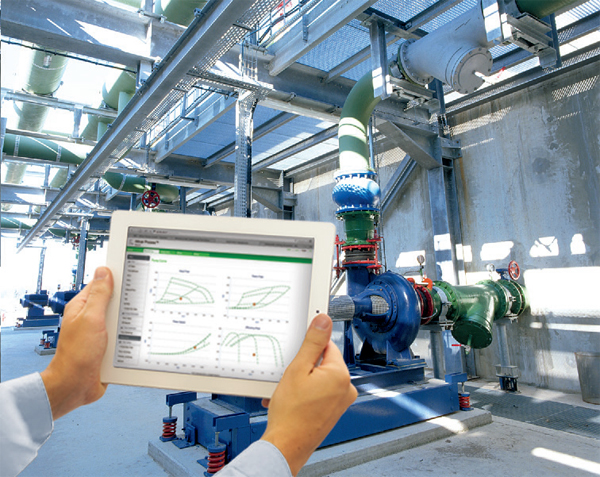Industrial Automation Will Create A Future-Proof Industry
By Louis Arone

The arrow is pointing up for the water and wastewater industry, thanks to funding and technology advances, but certain work remains to ensure the promise is fulfilled.
The past year and a half have tested the patience of all industries, particularly the water and wastewater sectors. The recent bipartisan U.S. infrastructure bill took nearly three months after it passed the Senate to be approved by the House. And although the Infrastructure and Jobs Act was officially signed into law late last year, the industry is still anxiously waiting for further negotiations around the allotment of those and additional funds.
However, progress has been made, and many industry leaders remain hopeful for 2022 — with funding of $55 billion for the water infrastructure and $8 billion for the western United States’ infrastructure specifically.1 So exactly how will the bill’s implementation support the industry this year and for years to come, as climate change and aging infrastructure continue to impact our existing systems?
The answer is creating sustainable and resilient infrastructures through industrial automation. Through funding and investment of software-driven digital transformation, we can make the promise of the infrastructure bill a reality for the water industry.
The Three-Step Journey For A Greener Future
There is a simple path to sustainability for the water and wastewater industry. Starting with industrial automation, the infrastructure bill can help municipalities take three critical steps to transform their sustainability goals into tangible results for a greener future.
To achieve a net-zero operations industry,2 organizations must:
- Reduce energy across operations using data. A wealth of data makes the invisible visible and can be analyzed and translated into actionable intelligence for energy and operational efficiencies.
- Substitute existing energy sources for cleaner alternatives. With electricity being the most efficient form of energy, it can serve as the best vector of decarbonization.
- Engage the supply chain as part of wider decarbonization efforts. According to a 2020 CDP study,3 supply chain emissions are more than 11 times higher, on average, than operational emissions. The water industry is an integral one, as one of the few resources that is needed for virtually all transformation processes that have production activities. And because the supply chain is often the largest part of an organization’s carbon footprint, the water industry must take a strategic approach here to help reduce organizations’ overall emissions.
Funding The Right Investments To Make The Industry Future-Proof
The funding included in the infrastructure bill is a necessary opportunity to upgrade our water and wastewater infrastructure and facilities. In the $55 billion water infrastructure investment, the funding includes $15 billion for lead pipe replacement, $10 billion for chemical cleanup, and money to provide clean drinking water in tribal communities.
When investing the actual dollars, our highest priority should not only be focused on communities that are the most at risk but also concentrating our efforts on how we can accelerate water reuse, water loss, and energy-efficiency projects — something the bill is aiming to address specifically in the funding for western water infrastructure. At least $8 billion will be put into addressing water treatment, storage, and reuse facilities that have been devastated by ongoing drought conditions in the western half of the country.
To successfully invest these dollars, it means we must take advantage of new technologies. We do not, and should not, build plants like we did 20 to 30 years ago. Moving forward, our systems need to be sustainable and smart. To ensure resilient systems, this means building future-proof plants and networks, taking advantage of the digital transformation and the tools that exist today.
The year 2022 will be an exciting year for the water and wastewater industry because now we have access to technology that we never had in the past with a drastically smaller cost, thanks to the cloud. All the cloud-based predictive analytics are allowing the industry to move from reactive to proactive. Based on operational efficiency, these tools can help operate water facilities and municipalities more efficiently.

A mock-up of a universally automated wastewater facility.
Cybersecurity Concerns On The Rise
If we invest our money and energy in industrial automation, we anticipate cybersecurity concerns to take center stage with all the tools being managed in the cloud.
Up until this point, we’ve been accustomed to a privatized world of industrial automation. When you think of our own private lives, half of us live in an Apple universe and the other half in an Android one, with Amazon (Alexa) acting as an occasional third player in home automation. These devices don’t always play well together, so many naturally stay with one vendor.
Customers tend to choose one programmable logic controller (PLC) vendor and end up stuck with software and hardware provided by that single seller. Known as “vendor lock-in,” this stifles innovation and limits the customer to only the options that vendor provides. For example, a PLC is configured at the factory using software provided by the manufacturer of the PLC. As the customer, they have no choice but to use their software and their hardware because the two are tightly intertwined. And, unlike end users who can control what goes in their plants, municipalities don’t have the luxury of choosing their sole vendor.
This is where industrial automation comes in — specifically universal automation, which allows facilities to use software on any hardware compatible with it. Software such as EcoStruxure Automation Expert, an asset-centric automation system designed to manage the complete automation lifecycle for next-generation industries, is an example of a technology that municipalities can integrate to adapt to the software-driven digital transformation. The software addresses customers’ needs for flexibility, interoperability, and efficiency from industrial operations standards.
Plants must modernize every 20 years or so. Through universal automation, costs associated with modernizing are lower and downtime with facility updates are largely eliminated, as it bypasses vendor lock-ins by allowing the use of another seller’s technology or product. The promise is that all vendors will create smart products (hardware and software) that adhere to the IEC614994 and universal automation standards. This will create an environment where the customer can choose best-in-class products from any manufacturer now and into the future.
Looking Toward The Future
Our water industry is facing unprecedented challenges. With an aging infrastructure that is battling unparalleled environmental changes associated with climate change, it is critical that leaders focus their investments to create resiliency of our water and wastewater facilities.
Universal automation is the latest big step forward in automation technology and coincides with the three-step path to transform the water and wastewater industry’s sustainability goals into tangible results for a sustainable, net-zero future.
References
- https://www.whitehouse.gov/briefing-room/statements-releases/2021/11/06/fact-sheet-the-bipartisan-infrastructure-deal/
- https://www.se.com/us/en/about-us/newsroom/news/press-releases/schneiderelectric-unveils-three-step-path-toward-sustainability-and-holistic-climateaction-618187d1a0ff63747d34c423
- https://www.cdp.net/en/research/global-reports/transparency-totransformation
- https://webstore.iec.ch/publication/5506
 About The Author
About The Author
Louis Arone is a manager of the System & Architectures Team, Industrial Automation Business, at Schneider Electric U.S. Arone is skilled in process automation, control systems design, motor control, VFDs, PLCs, HMIs, and SCADA systems.
